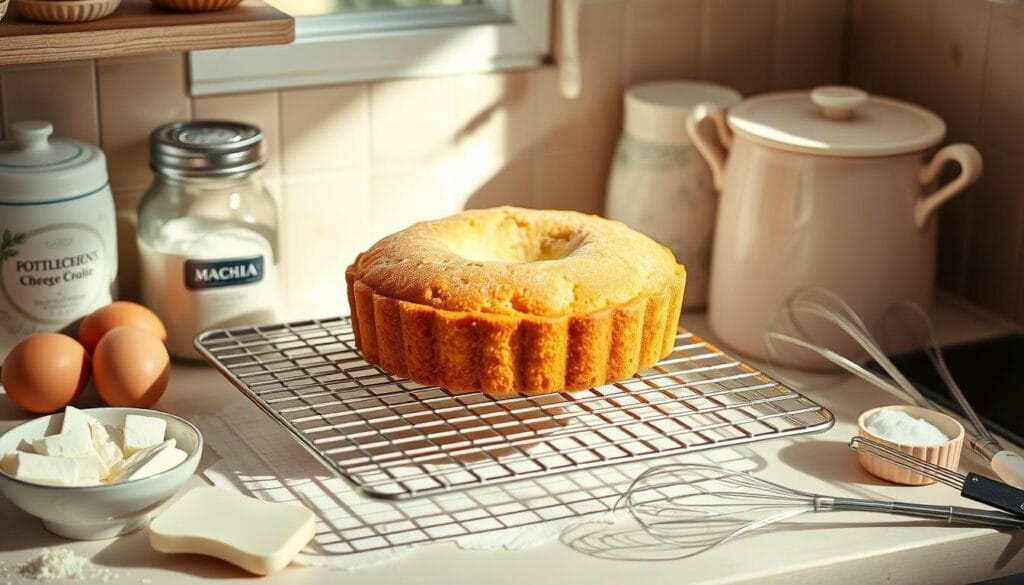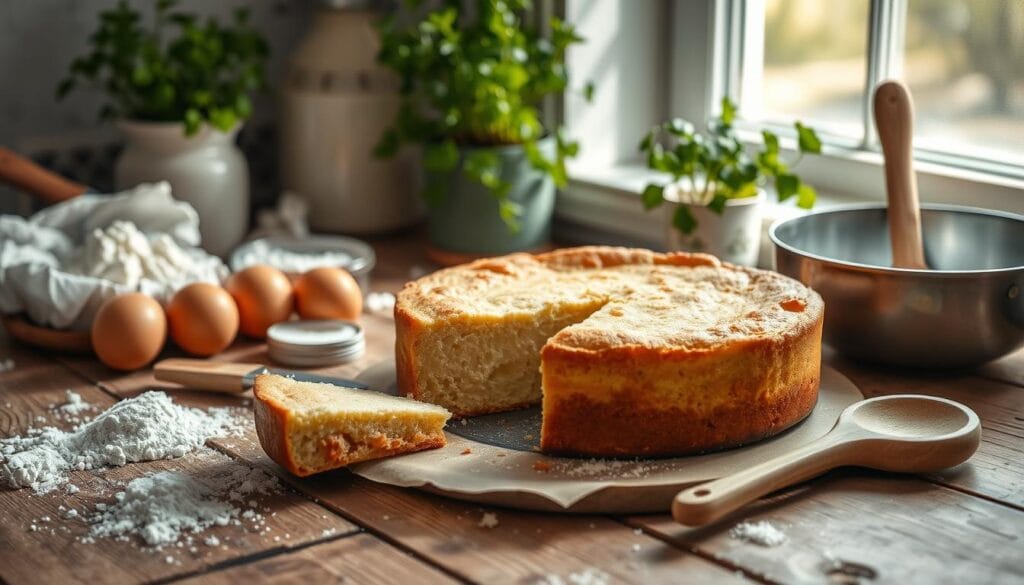Moist cottage cheese cake baking tips
Baking a perfect cottage cheese cake needs skill and precision. It’s a journey to create a delicious dessert with creamy textures and rich flavors. Start your adventure here.

Cottage cheese adds a unique twist to traditional cake recipes. It can make your baking better, whether you’re new or experienced. Learning to make cottage cheese cake opens up new possibilities in the kitchen.
Table of Contents
Understanding the Magic of Cottage Cheese in Baking
Cottage cheese is changing the game in healthy protein desserts. It’s a secret ingredient that makes treats both delicious and nutritious. This versatile food adds special qualities that take your desserts from good to great.

Baking with cottage cheese opens up new possibilities in the kitchen. Its unique qualities make desserts moist and packed with protein. You don’t have to sacrifice taste or texture.
Nutritional Powerhouse for Desserts
Cottage cheese is a nutritional superstar for desserts. Here’s why:
- It’s high in protein, which helps muscles recover
- It has less fat than traditional cream cheese
- It’s full of important nutrients like calcium and phosphorus
Texture Transformation in Baking
The magic of cottage cheese is in its ability to make baked goods moist and tender. Its texture helps:
- Keep cakes and pastries moist
- Make them creamy and smooth
- Reduce the need for extra fats
| Ingredient | Protein Content | Moisture Impact |
|---|---|---|
| Cottage Cheese | 14g per cup | High moisture retention |
| Cream Cheese | 8g per cup | Medium moisture |
| Greek Yogurt | 12g per cup | Good moisture retention |
Protein-Rich Baking Benefits
Using cottage cheese in your baking means making healthy protein desserts. These desserts are not only tasty but also nourishing. The protein in cottage cheese helps:
- Keep blood sugar levels stable
- Make you feel full longer
- Support muscle health
“Cottage cheese isn’t just a diet food—it’s a baking revolution!” – Culinary Nutritionist
Essential Ingredients for the Perfect Cottage Cheese Cake
Making a tasty cottage cheese cake begins with picking the right ingredients. Knowing how each part affects the cake’s texture and taste is key.
A great cottage cheese cheesecake needs top-notch ingredients. Let’s look at what’s crucial:
- Cottage cheese (the star ingredient)
- Cream cheese for extra richness
- Large eggs for structure
- Granulated sugar
- All-purpose flour or almond flour
- Vanilla extract
Cottage cheese is vital for the cake’s texture. The type you choose greatly affects the outcome.
| Cottage Cheese Type | Fat Percentage | Cake Texture Impact |
|---|---|---|
| Low-fat (1%) | 1% | Lighter, less creamy texture |
| Whole milk (4%) | 4% | Rich, smooth, and creamy |
| Full-fat (5%+) | 5-6% | Extremely dense and luxurious |
“The quality of your ingredients determines the soul of your cottage cheese cake.” – Professional Baker’s Secret
Pro tip: Use room temperature ingredients for the smoothest batter. This avoids lumps and ensures a uniform mix.
- Optional flavor enhancers:
- Lemon zest
- Cinnamon
- Almond extract
Try different ingredients to make your cake special. The right mix turns a simple dessert into a memorable treat.
Preparing Your Cottage Cheese for Baking
Making a great cottage cheese dessert begins with the right prep. Turning cottage cheese into a smooth, creamy base is key. This makes your dessert stand out.
Success in baking depends on a few important steps. These steps turn cottage cheese into a top-notch ingredient for your treats.
Draining and Straining Techniques
Too much moisture can ruin your cottage cheese dessert. Here’s what to do:
- Use a fine-mesh strainer or cheesecloth
- Drain for 15-30 minutes at room temperature
- Gently press to remove extra liquid
Achieving the Right Consistency
The texture of your cottage cheese mousse is all about prep. Different recipes need different textures:
| Desired Texture | Preparation Method | Best For |
|---|---|---|
| Smooth | Blend until creamy | Cheesecakes |
| Slightly Chunky | Minimal straining | Rustic Desserts |
| Ultra-Smooth | Strain and food process | Mousse |
Temperature Considerations
Temperature is key for your cottage cheese dessert. Always bring cottage cheese to room temperature before mixing. This ensures it blends well with other ingredients.
“Room temperature ingredients blend more evenly and create a more consistent texture.” – Professional Bakers’ Wisdom
Pro tip: Take cottage cheese out of the fridge 30-45 minutes before using it. This simple step can greatly improve your baking.
Mixing Techniques for a Smooth Cottage Cheese Batter
Making a silky smooth cottage cheese cheesecake requires the right mixing technique. The batter’s smoothness is key to a great cottage cheese cake. So, it’s important to know how to mix it well.
“The secret to a perfect cottage cheese cake is in the mixing method.” – Professional Pastry Chef
Here are the main mixing strategies for your cottage cheese cheesecake:
- Use room temperature ingredients for smoother blending
- Break down cottage cheese curds thoroughly
- Mix ingredients gradually to prevent lumps
- Avoid overmixing the batter
The tools you use can affect the texture of your cheesecake. Here’s a quick look at different mixing methods:
| Mixing Tool | Pros | Cons |
|---|---|---|
| Food Processor | Ultra-smooth texture | Risk of overprocessing |
| Hand Mixer | More control | Potential for lumps |
| Blender | Consistent blending | Can incorporate too much air |
Pro tip: Strain your cottage cheese before mixing to remove excess moisture and ensure a creamy cottage cheese cake texture.
When adding fruits or chocolate chips, gently fold them in. This keeps the batter smooth. It also helps your cheesecake stay light and delicate.
Temperature Control Secrets for Moist Results
Creating the perfect cottage cheese dessert needs mastering temperature. Your healthy protein desserts depend on knowing how heat affects baking. The right temperature turns an ordinary cake into a culinary masterpiece.
Achieving a moist and delicious cottage cheese cake requires careful temperature management. This is key throughout the baking process.
Optimal Oven Settings
The right oven temperature is crucial for your healthy protein desserts. Experts suggest:
- Preheat the oven to 325°F-350°F for consistent results
- Use middle rack for even heat distribution
- Avoid temperature fluctuations during baking
Water Bath Methods
A water bath creates a gentle, humid environment for your cottage cheese dessert. This method prevents cracking and ensures a smooth texture.
| Water Bath Technique | Benefits |
|---|---|
| Wrap pan in foil | Prevents water seepage |
| Use hot water | Maintains consistent temperature |
| Place pan in larger baking dish | Creates steam environment |
Cooling Procedures
Proper cooling is key for keeping moisture in your cottage cheese dessert. Gradual cooling prevents structural collapse and preserves delicate texture.
“Patience during cooling is the baker’s secret weapon” – Professional Pastry Chef
- Turn off oven, leave cake inside with door slightly open
- Cool at room temperature for 1-2 hours
- Refrigerate only after complete cooling
By mastering these temperature control techniques, you’ll make irresistibly moist healthy protein desserts. These will show off cottage cheese’s amazing baking potential.
Preventing Common Cottage Cheese Cake Mishaps
Making the perfect cottage cheese cheesecake can be tricky. Even experienced bakers face challenges. Knowing the common problems helps you make a dessert that wows everyone.
Cracking is a big problem when baking a cottage cheese cake. It often happens because of:
- Overmixing the batter
- Rapid temperature changes
- Incorrect oven settings
To avoid cracking, try these expert tips:
- Gently fold ingredients to avoid air pockets
- Use room temperature cottage cheese and eggs
- Bake in a water bath
- Cool slowly at room temperature
Pro tip: A slight crack doesn’t mean failure. Creative toppings like fresh berries or whipped cream can beautifully camouflage minor imperfections.
“Perfection in baking comes from understanding your ingredients and respecting their unique characteristics.” – Professional Baker’s Wisdom
Uneven texture often comes from cottage cheese not being prepared right. Drain excess moisture and blend until smooth. This ensures a creamy, even cottage cheese cake.
High-altitude bakers need to adjust. Reduce leavening agents and add a bit more liquid to handle the pressure.
Creative Flavor Variations and Additions
Making your cottage cheese dessert better doesn’t have to be hard. Just a few simple changes can turn a basic recipe into a treat that’s both tasty and healthy.
Seasonal Fruit Combinations
Fruit can really boost your cottage cheese cake’s taste. Each season brings new chances to make desserts that stand out:
- Summer: Fresh berries like strawberries, blueberries, and raspberries
- Autumn: Roasted apples, poached pears, and caramelized figs
- Winter: Citrus zests and dried cranberries
- Spring: Rhubarb, cherries, and light tropical fruits
Complementary Spice Blends
Spices can make a simple cottage cheese dessert amazing. Here are some great spice combinations:
| Spice Blend | Flavor Profile | Best Paired With |
|---|---|---|
| Cinnamon & Nutmeg | Warm, comforting | Apple, pear desserts |
| Cardamom & Ginger | Exotic, slightly spicy | Citrus and tropical fruits |
| Lavender & Vanilla | Subtle, elegant | Berry and stone fruits |
Healthy Sweetener Alternatives
You can make delicious healthy protein desserts without using too much sugar. Try these natural sweeteners:
- Stevia: Zero-calorie plant-based sweetener
- Monk fruit extract: Natural, low-glycemic option
- Pureed fruits: Adds natural sweetness and nutrients
- Honey: Minimally processed with trace minerals
“Creativity in baking is about balancing flavor, nutrition, and pure enjoyment.” – Culinary Nutrition Expert
By trying out these ideas, you’ll make cottage cheese desserts that are not only good for you but also really enjoyable.
Storage and Serving Recommendations
Keeping your cottage cheese cake fresh is key. Whether it’s a creamy mousse or a classic cake, the right care makes all the difference. This ensures every bite is as delightful as the first.
Storing your cake in the fridge is essential. Here are some tips to keep it perfect:
- Wrap the cottage cheese cake tightly in plastic wrap
- Store in an airtight container to prevent moisture loss
- Refrigerate at 40°F (4°C) or below
- Consume within 3-5 days for optimal freshness
Freezing your cake can make it last longer. Pro tip: Slice it before freezing for easier serving.
| Storage Method | Recommended Duration | Best Practices |
|---|---|---|
| Refrigerator | 3-5 days | Wrap tightly, use airtight container |
| Freezer | 1-2 months | Wrap in freezer-safe paper, double-wrap for protection |
“The secret to a perfect cottage cheese cake is not just in the baking, but in the careful preservation of its delicate texture.” – Pastry Chef Recommendation
When serving your cake, pay close attention. Take it out of the fridge 15-20 minutes before serving. This lets it warm up a bit, improving both taste and texture.
- Garnish with fresh berries
- Dust with powdered sugar
- Pair with a light whipped cream
Your homemade cottage cheese cake is worth the extra care. By following these tips, you’ll enjoy a dessert that’s as delicious as it is fresh.
Transforming Traditional Recipes into Cottage Cheese Versions
Turning classic desserts into cottage cheese versions can change your baking. You can make healthier, protein-rich desserts from your favorite cheesecakes and cakes. Just make a few tweaks.
To change recipes, you need to swap ingredients and know how cottage cheese works. Here are some tips for making the switch:
- Replace cream cheese with smooth, drained cottage cheese
- Adjust liquid ratios to maintain optimal moisture
- Blend cottage cheese until ultra-smooth for consistent texture
- Reduce overall fat content while increasing protein
Here are some tips for making a cottage cheese cheesecake:
- Strain cottage cheese through cheesecloth to remove excess moisture
- Use a food processor to achieve a creamy consistency
- Experiment with different fat percentages of cottage cheese
“The secret to a perfect cottage cheese dessert is patience and technique.”
Many recipes can be made with cottage cheese, like New York-style cheesecake and no-bake cheesecakes. Even layer cakes can be made with cottage cheese. Each one is a protein-rich alternative to traditional desserts.
Your creativity in baking can turn regular recipes into healthy, tasty cottage cheese treats. These desserts will please both those who care about health and those who love great flavors.
Conclusion
Starting your journey with cottage cheese cake recipes is exciting. It turns simple desserts into healthy treats. These recipes mix taste, texture, and health in every bite.
Learning to bake with cottage cheese opens up many possibilities. You can make moist, protein-packed desserts that taste great and are good for you. Try new fruits or flavors to make your cottage cheese cake stand out.
Baking is all about passion, practice, and trying new things. Every cottage cheese cake you make is a chance to get better and learn. Trust your instincts and enjoy the yummy results of your baking skills.
Your journey with cottage cheese cakes is just starting. Keep trying new things and making each cake your own. The kitchen is your space to be creative. Enjoy making and tasting your delicious creations.
FAQ
Can I use low-fat cottage cheese in my cottage cheese cake?
Absolutely! Low-fat cottage cheese works well in cake recipes. But, full-fat varieties give a richer, creamier texture. If using low-fat, add a bit more fat (like Greek yogurt or butter) to keep it moist and rich.
How can I prevent my cottage cheese cake from becoming too watery?
To avoid too much moisture, drain the cottage cheese well. Use a fine-mesh strainer or cheesecloth for 15-20 minutes. You can also pulse it in a food processor to make it smoother before mixing it into the batter.
Is cottage cheese cake a good option for high-protein diets?
Yes! Cottage cheese cake is a great choice for high-protein desserts. It has about 12-15 grams of protein per cup. It’s a tasty alternative to traditional cheesecake for those who want more protein.
Can I freeze a cottage cheese cake?
You can freeze cottage cheese cake for 2-3 months. Wrap it in plastic wrap and then foil to avoid freezer burn. Thaw it in the fridge overnight. The texture might change, but the taste stays great.
What’s the best way to achieve a smooth cottage cheese cake texture?
For a smooth texture, blend the cottage cheese until it’s completely smooth. Use a food processor or blender. Make sure all ingredients are at room temperature and mix just until combined to avoid a tough cake.
Are there any dairy-free alternatives for cottage cheese in this cake?
Yes, you can use silken tofu, cashew cream, or plant-based cottage cheese substitutes. Each will change the texture and flavor. You might need to try a few to find the right one for your diet.
How long can I store a cottage cheese cake in the refrigerator?
Store a cottage cheese cake in the fridge for 3-5 days. Always cover it tightly with plastic wrap or in an airtight container. This keeps it fresh and prevents odors.
Can I make a cottage cheese cake without a springform pan?
Yes, you can use a regular cake pan, glass baking dish, or a lined baking sheet. If using a regular pan, line it with parchment paper. Adjust baking times and watch it closely to avoid overbaking.


